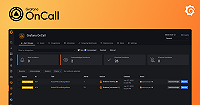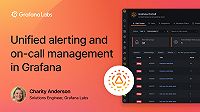Caution
As of 2025-03-11, Grafana OnCall OSS has entered maintenance mode, and will be archived on 2026-03-24. No further feature development will occur; however, we will still provide fixes for critical bugs and for valid CVEs with a CVSS score of 7.0 or higher. For more information, refer to our blog post.
Important: This documentation is about an older version. It's relevant only to the release noted, many of the features and functions have been updated or replaced. Please view the current version.
Kapacitor integration for Grafana OnCall
The Kapacitor integration for Grafana OnCall handles ticket events sent from Kapacitor webhooks. The integration provides grouping, auto-acknowledge and auto-resolve logic via customizable alert templates.
Configuring Grafana OnCall to Receive Alerts from Kapacitor
- In the Integrations tab, click + New integration.
- Select Kapacitor from the list of available integrations.
- Enter a name and description for the integration, click Create
- A new page will open with the integration details. Copy the OnCall Integration URL from HTTP Endpoint section.
Configuring Kapacitor to Send Alerts to Grafana OnCall
To send an alert from Kapacitor, you can follow these steps:
- Create a Kapacitor TICKscript or modify an existing one to define the conditions for triggering the alert. The TICKscript specifies the data source, data processing, and the alert rule. Here’s an example of a simple TICKscript:
stream
|from()
.measurement('measurement_name')
.where(lambda: <condition>)
|alert()
.webhook('<webhook_url>')Replace 'measurement_name' with the name of the measurement you want to monitor, <condition>
with the condition that triggers the alert, and '<webhook_url>' with OnCall Integration URL
2. Save the TICKscript file with a .tick extension, for example, alert_script.tick.
3. Start the Kapacitor service using the TICKscript:
kapacitor define <alert_name> -tick /path/to/alert_script.tick
kapacitor enable <alert_name>
kapacitor reloadReplace <alert_name> with a suitable name for your alert.
4. Ensure that the Kapacitor service is running and actively monitoring the data.
When the condition defined in the TICKscript is met, Kapacitor will trigger the alert and send
a POST request to the specified webhook URL with the necessary information. Make sure your webhook
endpoint is configured to receive and process the incoming alerts from Kapacitor.



